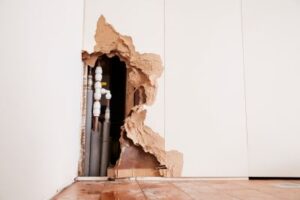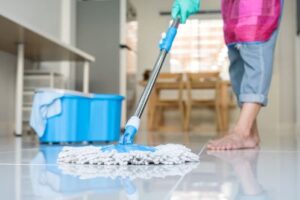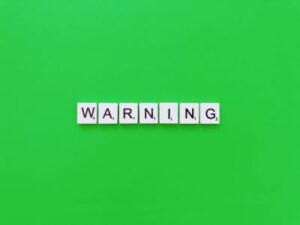Fixing Water Damaged Walls in Your Home
Water damage can cause a lot of problems in your home. Not only can it lead to mold growth, but it can also damage your walls and other surfaces in your home.
So, how do you fix water-damaged walls? The best way to fix water-damaged walls is to first remove any excess water. You can do this by using a wet vacuum or a mop. Once the water is removed, you can begin to repair the damage.
You may need to replace drywall or insulation that has been damaged by the water. If the wall is structurally compromised, you may need to consult a professional to determine the best course of action.
In this blog post, we will discuss how to fix water-damaged walls. We will also talk about the top causes of water damage in homes and how to prevent it from happening to you. Finally, we will provide some tips on how to best fix water-damaged walls.
 Top Causes of Water Damage in Homes
Top Causes of Water Damage in Homes
Many things can cause water damage in your home. Some of the most common causes include:
Leaks in Your Roof
Leaks in your roof are one of the most common causes of water damage. If you leak in your roof, it is important to fix it as soon as possible. A small leak can turn into a big problem if left untreated.
Clogged Gutters
If your gutters are clogged, water will not be able to flow properly and will likely overflow. This can cause water damage to your home’s exterior and foundation.
Broken Pipes
A broken pipe is another common cause of water damage. If you notice that there is water pooled around pipes in your home, this may be an indication that they are broken.
Poor Drainage
If the ground surrounding your home does not drain properly, it can lead to water accumulation. This can cause water damage to your home’s foundation and exterior.
Signs of Water Damaged Walls
If you think that your walls may be water damaged, there are a few signs to look out for. Some of the most common signs include:
Water Stains
One of the most telltale signs of water damage is water stains. If you see any discoloration or moisture on your walls, this is a sign that they have been damaged by water.
Mold Growth
Mold growth is another sign of water damage. It can grow in places where there is excessive moisture, such as behind wallpaper or under carpets.
Peeling Paint
If the paint begins to peel off your walls, it could be a sign that they have been exposed to too much moisture.
How to Fix Water Damaged Walls
Now that we have talked about the top causes of water damage and how to prevent it, let’s take a look at how to fix water-damaged walls.
If the wall has been wet for less than 24 hours, you can often dry it out yourself. Remove any excess water with a wet vacuum or mop and then use a fan to dry the area. If the wall is made from drywall, you may need to cut out the section that was damaged and replace it with new drywall.
If the wall has been wet for more than 24 hours, you should contact a professional to help you repair the damage. The professional may need to remove the wall completely and replace it with new drywall.
Risks of Water Damaged Walls
Water damage can cause a lot of problems in your home, including mold growth and structural damage. If you have water damage, it is important to act quickly and repair the damage as soon as possible.
Health Problems
Unfortunately, mold can grow quickly in damp environments, so it is important to fix water damage as soon as possible. If left untreated, mold can cause health problems for you and your family.
Structural Damage
Water damage can also cause structural damage to your home. If the water is not dried out properly, it can lead to the development of mold and mildew, which can weaken the structure of your home.
If you have any questions about how to fix water-damaged walls, please contact a professional. They will be able to help you repair the damage and prevent further problems from occurring.
Tips for Fixing Water Damaged Walls
Once you have removed any excess water and repaired any damage, you can begin to repaint or wallpaper your walls. If the paint is peeling or the wallpaper is damaged, it is best to remove it before applying new paint or wallpaper.
It is also important to make sure that your walls are dry before you begin painting or wallpapering. You can use fans and dehumidifiers to help speed up the drying process. Once your walls are dry, you can apply primer and then paint or wallpaper as desired.
 Tools Needed to Fix Water Damaged Walls
Tools Needed to Fix Water Damaged Walls
If you are going to fix water-damaged walls yourself, some tools will come in handy. These include:
- Wet Vacuum
- Mop
- Bucket
- Sponge
- Paintbrush
- Paint Roller
- Ladder
- Tarp
If you have any questions about how to fix water-damaged walls, please contact a professional. They will be able to help you repair the damage and prevent further problems from occurring.
Preventing Water Damage in Your Home
Now that you know some of the top causes of water damage, you may be wondering how you can prevent it from happening to you. There are several things you can do to prevent water damage in your home:
Inspect Your Roof Regularly
One of the best ways to prevent water damage is to inspect your roof regularly. Look for any cracks or missing shingles and have them repaired as soon as possible.
Check Your Pipes and Fixtures Regularly
Another way to prevent water damage is to check your pipes and fixtures regularly for leaks. If you find a leak, make sure to repair it as soon as possible.
Know Where Your Water Main Shut-Off Valve Is
In the event of a major leak, it’s important to know where your water main shut-off valve is so you can quickly turn off the water to your home.
Be Prepared for Heavy Rains or Flooding
If you live in an area that is susceptible to heavy rains or flooding, make sure you are prepared. Have a plan in place for what you will do if your home is flooded.
Fix Leaks
If you have any leaks in your home, make sure to fix them as soon as possible. A small leak can turn into a big problem if left untreated. Some of the common places you may find leaks include pipes, fixtures, windows, and doors.
Clean Gutters
Make sure to clean your gutters regularly so that they will be able to properly drain rainwater away from your home.
Check for Broken Pipes
If you notice any water pooled around pipes in your home, check them for cracks or leaks.
Install Gutter Guards
Gutter guards can help to prevent leaves and other debris from clogging your gutters.
Fix Poor Drainage
If the ground around your home does not drain properly, consider having a drainage system installed.
 Final Thoughts
Final Thoughts
If you notice warning signs of water damage in your walls, or if you spot an active water leak, it is important to take action as soon as possible. Water damage can cause serious problems in your home, including structural damage and the development of mold and mildew.
Preventing water damage is important for the safety and security of your home. There are several things you can do to prevent water damage, including inspecting your roof and pipes regularly, preparing for heavy rains or flooding, and cleaning your gutters.
If you have any questions about how to fix water-damaged walls, please contact a professional. They will be able to help you repair the damage and prevent further problems from occurring.
Related Questions
What are other top causes of damage to homes?
Fire is another common hazard that can cause extensive damage to your home. If you have a fire in your home, it’s important to take action as soon as possible to minimize the damage. Fire damage can be repaired, but it takes time and money, so it’s best to take preventative measures wherever possible.
Can a wall collapse from water damage?
Water damage can cause a wall to collapse if it is not repaired properly. It’s important to take action as soon as possible if you notice water damage in your home. Water-damaged walls should be fixed by a professional to ensure that they are structurally sound.
What should you do if your home is flooded?
If your home is flooded, it’s important to take action as soon as possible. Turn off the water main, evacuate your home, and contact a professional to help you clean up the mess. Flood damage can be costly and time-consuming to repair, so it’s best to take preventative measures wherever possible.
How long does it take for mold to grow after water damage?
Mold can start growing within 48 hours of exposure to moisture. It’s important to take action as soon as possible if you notice any signs of water damage in your home. Water-damaged walls should be fixed by a professional to ensure that they are free of mold and mildew.
